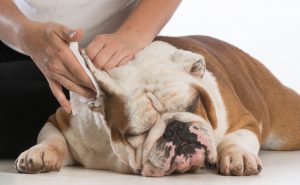What You Need
- Ear cleaning solution: Look for a quality ear cleaner recommended by veterinarians. A top choice of professionals is Epi-Otic by Virbac. Avoid ear cleansers that contain alcohol or hydrogen peroxide as these can cause irritation.
- Cotton balls, cotton pads, or gauze squares
- Cotton-tipped applicators
- Tweezers or hemostats (for dogs with too much hair in the ear canals)
- A towel or two
Add Ear Cleaner
Begin by holding the ear flap up and squirting a few drops of ear cleaner on the inside of the flap near the ear opening. Next, gently place the tip of the bottle into the ear no further than you can see (not too deep). Give the bottle a gentle squeeze. Do not use an excessive amount of pressure when squeezing the cleanser into the ear.
Massage the Ear
Before the dog can shake its head, begin massaging the base of the ear (this is the bottom part near the jaw where cartilage can be felt). You should be able to hear a smacking sound.
By massaging, you are helping the cleanser fill the ridges in the canal and loosen ear debris. After massaging for a few seconds (more for very dirty ears) you can let go and allow your dog to shake. You might want to turn away or hold up a towel for this part.
Wipe the Ear Canal
Once your dog has a good shake, lightly moisten cotton or gauze with ear cleaner. Use the cotton or gauze with your finger to wipe out the ear canal. You can put your finger in the ear canal as far as it will go without forcing it.
You may wish to use cotton-tipped applicators to clean stubborn debris out of the ridges of your dog’sear. Very important: Never put the cotton-tipped applicators into the ear any further than you can see. Damage to the eardrum can occur!
If the ear still seems dirty, you may repeat the process. Stop if your dog’s ear begins to get red or bleed or your dog seems to be in pain.
Clean the Other Ear
Move on to the other ear and repeat all the steps. Finish by wiping away any visible debris and drying your dog’s head off. Make sure to offer a treat reward and plenty of praise!
The Anatomy of a Dog’s Ears
It’s always a good idea to familiarize yourself with your dog’s anatomy for grooming care like this. This can help you prevent any damage and get a better understanding of what you’re looking at while cleaning. A dog’s ear is a fairly complex structure:
- The visible outside flap of the ear is called the pinna. This pinna will flop in some dogs while in others it stands up straight. Floppy ears may allow less airflow to the ear canal, making some floppy-eared dogs more prone to ear infections.
- Just inside the visible ear opening is the external canal. This canal travels down the side of the head (vertical canal), then takes a turn inward (horizontal canal). The canal is skin-covered and contains cartilage that creates ridges and creases on the surface. The external canal also contains glands that secrete wax and oils (sebum) into the ear.
- The external canal ends at the eardrum (tympanic membrane). This is a thin piece of tissue that vibrates in response to sound waves and assists in hearing. The tympanic membrane also protects the middle and inner ear.
- Beyond the eardrum is the middle ear followed by the inner ear. These areas contain the delicate structures associated with hearing and balance. Damage to the inner or middle ear can cause significant harm to a dog’s hearing and balance. In some cases, the damage is even permanent.
How to Prevent Your Dog From Getting Ear Infections
When it comes to ear cleaning, the focus is on the external ear canal. Ear wax and debris can easily build up in the ridges of the external canal. If irritation and inflammation (otitis) occur (either from debris buildup or from allergies), the canal can become infected. Lack of adequate air flow to the canal can expedite an ear infection.
This is part of the reason dogs with long, floppy ears are prone to ear infections. However, some dogs also have an excessive amount of glands in their ear canals and produce too many secretions. Cocker Spaniels and Basset Hounds are a couple of breeds with genetic predispositions to ear infections.
Typically, dogs with ear infections will have an excessive amount of bacteria or yeast in the ears. External ear infections cause itching and pain. They can also lead to middle and inner ear infections that affect hearing and balance. In addition, because dogs with itchy or sore ears tend to shake their heads violently, they can rupture blood vessels in the ear flap and end up with a pocket of blood in the flap called an aural hematoma.
Signs of an ear infection include odor from the ears, frequent shaking of the head, redness of the skin inside ears, excessive scratching at ears, and excessive ear discharge or debris.
Regular cleaning can help prevent ear infections. Using an appropriate ear cleaner, you can release wax and debris from the canal and help dry the ear.
Dogs can build up wax and debris at a faster rate than people. Some dogs have very little ear buildup and simply need their ears wiped out occasionally. Other dogs need thorough ear cleanings every week or two. Inspect your dog’s ears regularly and talk to your vet about your dog’s needs. Over-cleaning can cause irritation, but under-cleaning can make way for excessive buildup.

